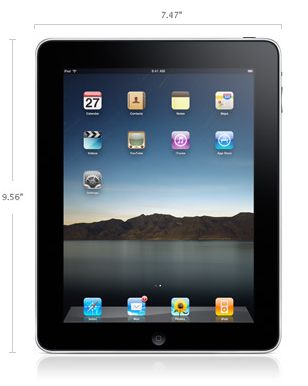Some interesting data
For the inner nerd in all of us, I did a bit of figuring to see how the display area of the two devices compares – iPad and iPhone.
These are for the display, not the outer dimensions of the devices.
I made these measurements by printing a copy of the iPad’s picture from Apple’s web site for the iPad and measuring/computing, and by actual measurement of the display area on my iPhone.

Full display area
iPhone: 2.95″ x 1.95″ = 5.75 in^2 (native ratio is 1.51:1. 3.54″ display diagonal)
iPad: 7.86″ x 6.17″ = 48.5 in^2 (native ratio is 1.27:1. 10.0″ display diagonal)
Ratio iPad:iPhone = 8.4:1 area, 2.82 :1 diagonal)
Watching a widescreen 16:9 movie
iPhone: 2.95″ x 1.66″ = 4.90 in^2 (85% utilization. 3.39″ display diagonal)
iPad: 7.86″ x 4.42″ = 34.75 in^2 (72% utilization. 9.02″ display diagonal)
Ratio iPad:iPhone = 7.10:1 area, 2.66:1 diagonal)
Watching a 4:3 traditional movie
iPhone: 2.60″ x 1.95″ = 5.07 in^2 (88% utilization. 3.25″ display diagonal)
iPad: 7.86″ x 5.90″ = 46.37 in^2 (96% utilization. 9.83″ display diagonal)
Ratio iPad:iPhone = 9.15:1 area, 3.02:1 diagonal)
Looking at a Leica aspect ratio picture – 36mm x 24mm:
iPhone: 2.93″ x 1.95″ = 5.70 in^2 (99% utilization. 3.52″ display diagonal)
iPad: 7.86″ x 5.24″ = 41.19 in^2 (85% utilization. 9.45″ display diagonal)
Ratio iPad: iPhone = 7.23:1 area, 2.68:1 diagonal)
The iPad’s near 4:3 display area aspect ratio means it makes very efficient use of the available display area when playing a 4:3 movie or displaying a traditionally sized photo. On the other hand, the iPhone makes better use of available pixels when displaying a widescreen movie or a Leica aspect ratio (1.5:1) picture.
It would have been nice had the iPad adopted a slimmer aspect ratio for the screen rather than the traditional squarish 4:3. The use of 4:3 may reflect a compromise to accommodate newspapers, books and magazines better. On the other hand, the gain in screen area over the iPhone is very large in all instances profiled above.
For comparison, most netbooks use a 10.1″ diagonal widescreen, making them very efficient for watching movies but less so for many applications which require a squarer screen. Netbooks typically display 1024 x 576 pixels compared to 1024 x 768 for the iPad and 480 x 320 for the iPhone. The iPhone is the ‘sharpest’ in terms of pixel density (smartphones like the Motorola Droid are sharper still), as follows:
Pixels per square inch:
iPhone: 26,700
iPad: 16,215
Netbook: 13,085
Finally, the reason that the iPad employs such a seemingly broad inactive bezel area (0.65″ and 0.9″ on the long and short sides, respectively) around the display area would appear to be to satisfy the physical need of having something to hold onto when used in the hand; extending the touchscreen all the way to the edge would cause all sorts of unintended activation issues.
To read all my iPad ruminations just click here.